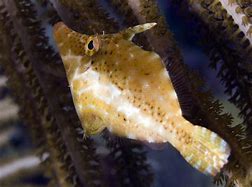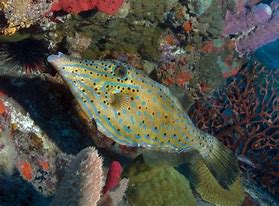Filefish



Filefish, also known as leatherjackets, are a group of fish species belonging to the family Monacanthidae. They are characterized by their compressed bodies, rough skin texture, and unique shape. Here are some interesting facts about filefish:
Appearance: Filefish have a distinct body shape, with a compressed and elongated body covered in small, rough scales that give them a file-like texture. They have a long, tubular snout and a small mouth. Their coloration can vary widely, ranging from vibrant hues of yellow, green, and blue to more subdued shades of brown or gray.
Mimicry and Camouflage: Filefish are well-known for their ability to mimic their surroundings, often resembling pieces of coral, rocks, or algae. This mimicry helps them blend in with their environment and provides camouflage from predators. Some species can change color and pattern to match their surroundings more accurately.
Diet: Filefish are primarily herbivorous and feed on algae and seagrasses. They use their specialized mouthparts to scrape and nibble on algae and other plant material. However, some species also consume small invertebrates, such as crustaceans and mollusks, as part of their diet.
Habitat: Filefish can be found in various marine environments, including coral reefs, rocky areas, seagrass beds, and shallow coastal waters. They are generally found in tropical and subtropical regions worldwide, but specific species may have more localized distributions.
Defense Mechanisms: When threatened, filefish have several defense mechanisms to protect themselves. Their rough skin texture and sharp spines make them unappetizing to potential predators. Some species can also inflate their bodies, making it difficult for predators to swallow them. Additionally, filefish may seek refuge in crevices or holes to avoid predation.
Reproduction: Filefish have diverse reproductive strategies. Some species are egg layers, with males and females releasing their gametes into the water column for external fertilization. Others, such as the Orangespotted Filefish (Oxymonacanthus longirostris), are known to form monogamous pairs and engage in elaborate courtship behaviors. They lay their eggs in a floating gelatinous mass.
Aquarium Trade: Some species of filefish are sought after for the aquarium trade due to their unique appearance and interesting behavior. However, filefish can be challenging to keep in captivity due to their specialized dietary requirements and potential compatibility issues with other tank mates. Care should be taken to provide a suitable environment and diet when keeping them in an aquarium.